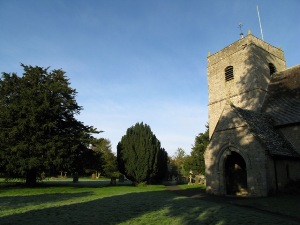The earliest parts of the Church date from the 12th century with many additions and alterations in the following centuries.

Church of St Mary the Virgin
A place of worship has probably stood on the site of the present church since Saxon times. Of the present building the Nave was built in the 12th Century (probably being the total extent of the Church at that time) and the Chancel, Vestry and South Porch were added in the 14th Century. The original Tower (of probable 15th Century origin) collapsed in 1728 and was replaced by present one in 1760.
There was a restoration of the whole Church under the London architect Henry Curzon, which was completed in 1864, at a cost of £2000!
There are a number of interesting architectural details and points of interest, which include:
Windows: The East window of four trefoiled lights depicts the four British Patron Saints. Four of the original deep lancet windows remain (three in the North Nave, one in the South) the others were probably replaced in the 14th Century by larger windows to improve the light - the two easternmost windows in the Nave are probably 14th Century (with more modern glass). The only old stained glass window is at the top beside the Pulpit.
Roof: The Chancel roof is of the trussed rafter type, with curved braces forming two-centred arches, and is of 14th Century origin. The Nave roof dates from the 1864 restoration, but the 16th Century tie-beam against the West wall remains and is finely carved, with a running vine ornamentation.
The recesses, the sedilia, and the piscina are all 14th Century.
The Bells. There is no record of the original bells, which may have been damaged at the time of the collapse of the Tower in 1728. A ring of five bells was cast for the rebuilt Tower, and records show that these were rehung in 1906. In 1950 the bells were all recast and new bells added, so that nowadays St Mary’s enjoys a ring of eight bells which is one of the finest in Herefordshire, and for which ringers come from far and wide.

Church of St Mary the Virgin
A new glass Millennium Screen was recently created which fills the Tower Arch, enabling the ringers to be viewed when ringing.
For the main part of each year a photographic exhibition is displayed in the space recently created at the back of the building. This depicts local scenes and is accompanied by carefully chosen and frequently familiar text or poetry and is very popular with visitors.



